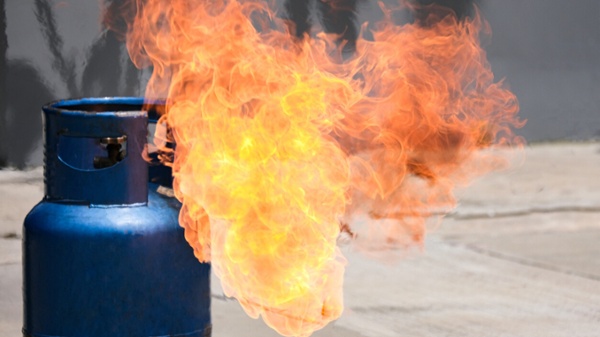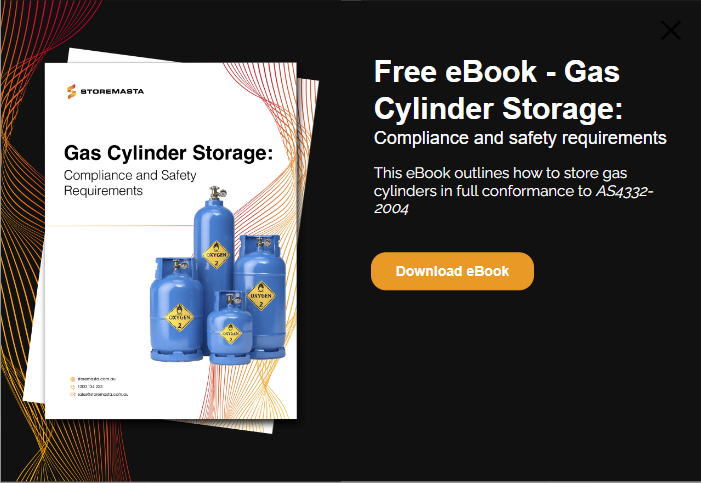Developing a solid relationship with your gas cylinder supplier is essential to maintaining a safe workplace that complies with WHS legislation in Australia. Gas cylinders are classed as dangerous goods and Australian Standard AS 4332 - The storage and handling of gases in cylinders has specific requirements for how gas bottles must be both received and returned to suppliers. But first, let’s look at gas cylinders — such as liquefied petroleum gas, welding or medical gas — and explain why they present a hazard if they are not being transported, handled or stored in the safest possible way.
Hazards Surrounding Compressed Gases in Cylinders
Gas cylinders present a complex range of hazards due to the combination of gas stored under pressure, the chemical properties and toxicity of the gases themselves, and the physical nature of the cylinders. Even ‘empty’ cylinders still contain residues of the gases held inside and their long slim design makes them vulnerable to drops, falls, or being knocked over.

There are multiple hazards associated with each subdivison of Class 2 gas cylinders.
Remember, you have a responsibility to ensure that all personnel and contractors understand the hazards associated with the gas bottles and cylinders that are found in your workplace. Your gas suppliers should already have trained their staff and delivery team to ensure that all safety precautions are being met so that the delivery process is an efficient and safe one.
These are many hazards identified by the Australian Standard for dangerous gases, including:
Pressure
The mechanical energy stored in a gas bottle is comparable with that of a motor car travelling at 180 km/h. Each cylinder has an incredible potential for damage if the cylinder is ruptured and explodes.
Flammability
When flammable gases leak into a confined space without being ignited, the concentration can quickly reach the flammable range and any small spark or ignition source (even static electricity) will cause an explosion. Some examples of flammable gases include LPG gas, methane and propane.
Reactivity
Some gases are highly reactive and can create explosions through a chemical reaction known as decomposition. When gases like acetylene become unstable (cylinders are shaken) or contact incompatible substances (copper) the gas begins to decompose — this generates heat and explosions.
Certain gases and their bottles are also vulnerable to corrosion, at the same time elastomeric components contained in storage and handling equipment can damage the cylinders through leaching, embrittlement, cracking or swelling. Damaged cylinders can create catastrophic leaks, contamination of gases, explosions and dangerous chemical reactions.
Toxicity
Human exposure to toxic and corrosive gases is extremely dangerous. Gases are usually inhaled but they can also be absorbed through the skin. Once inside the body, the toxic agents can damage internal organs or quickly cause the death of your workers.
Asphyxiant Hazard
Leaked gases displace the oxygen in the air. When oxygen levels drop below 18% there is a threat to life by asphyxiation. Gases like LPG, which are denser than air, tend to collect in low lying areas and quickly fill confined spaces.
Oxygen Enriched Atmosphere
When oxygen levels in the atmosphere increase above 21%, non-flammable substances can become flammable. This includes the clothing worn by workers. Ignition can occur from simple sources like heat, friction or static electricity.
Cold Hazard
Refrigerated gases or liquified gases that cool when depressurised can cause frostbite injuries and cold burns to workers who encounter the gas. The cold gases can also damage equipment creating brittle fractures or get stuck inside valves then rupture the fittings when heated.
Safely Receiving Cylinders
Gas cylinders should be thoroughly inspected on delivery and any cylinders which appear damaged, corroded or have loose/leaking fittings should be rejected and refused entry to the site. Develop a good relationship with your gas supplier and make sure their delivery team is trained to undertake the proper handling and unloading techniques.
The Standard has the following requirements when unloading cylinders and transferring them in the warehouse or worksite:
- Use mechanical handling devices like forklifts, pallet trucks or gas bottle trolleys when unloading and transferring cylinders
- Make sure the cylinders are always protected from being knocked over, falling or being impacted (use individual safety chains or cylinder restraints)
- Wear PPE applicable to the chemical and physiochemical hazards (thermal gloves, overalls, safety boots, eye guards etc)
- Never drop cylinders over the side of trucks or roll them along the ground (even for short distances).
- Keep cylinder valves closed and caps firmly in place.
- Loading and unloading areas must be designated NON-SMOKING and isolated from ignition sources, combustibles and sources of heat.
Storing and Handling Empty Cylinders
Completely used or partially empty cylinders shall be managed with the same precautions as full cylinders. Empty gas bottled should be labeled and placed in a separate area ready for collection by your gas cylinder supplier.
Don’t forget that empty cylinders must still be:
- Treated the same way as full cylinders and not thrown about, rolled along the ground, or carried by the valve
- Segregated according to hazard class
- Stored upright with the valve closed and cylinder cap in place
- Individually restrained
Developing a Good Relationship with your Gas Cylinder Suppliers
Are you working with LPG gas suppliers, oxygen suppliers or other Class 2 gas suppliers? Regardless of the type of gas that the supplier provides, companies that offer great customer service should be more than willing to assist your business in staying safe during the gas delivery process.
There are many factors to consider when developing relationships with your gas suppliers including:
- Preparing for your delivery so that safety is a top priority, including ensuring parking is available, all pathways are clear for the gas delivery, lighting and visibility is sufficient for the area, and there are no hazards (such as ignition sources or incompatible substances).
- Having trained staff handle the gas cylinders at the loading dock or delivery point, so that there is no confusion about how the gas cylinders should be delivered to your worksite.
- Speaking with your gas cylinder supplier regularly so that your empty cylinders are collected, reducing your onsite risk.
- Being able to ask your supplier for information on the correct disposal and recovery procedures for the gas bottles or cylinders.
- Ensuring that inventory is kept at a minimum level to reduce risk onsite.
- Having access to the latest safety data sheets in both hard copy and soft copy form (check their website for safety data sheet updates, as many suppliers do provide this service).
Returning Gas Cylinders to Your Supplier
The Standard has strict requirements for how gas bottles must be returned to the supplier —this includes both damaged and undamaged cylinders. Your duty of care to protect workers and contractors also extends to the delivery and collection team of your supplier, you must ensure that the cylinders don’t create a hazardous situation during transport.
Section 8.2 of AS 4332 requires that:
- Cylinders ready for pick-up by the supplier are kept in one safe area (most likely the cylinder store).
- Valves are tightly closed (without being over tightened) and cylinder caps are in place. Please take additional care to ensure any valves or plugs are secured on gas bottles that carry Class 2.3 toxic gases.
Damaged Gas Cylinders
Damaged cylinders must always be returned to the supplier, this includes corroded, fire-damaged or leaking cylinders. Contact your supplier in advance to notify them so that arrangements can be made.
The cylinders must be marked or tagged as damaged, then isolated to a safe, well-ventilated area. Follow the instructions of your supplier for safely storing them and minimising leaks. Damaged cylinders must never be returned under normal transport arrangements, so you’ll need to give your staff correct instructions and training.
Working with Class 2 DG and Gas Suppliers
For more information and accurate advice about storing and handling gas cylinders so your workplace complies with current WHS legislation in Australia, download our free eBook Gas Cylinder Storage: Compliance and safety requirements. It’s an excellent resource for WHS Managers or supervisors responsible for managing Class 2 dangerous goods held at your worksite.
Joining the team as a Dangerous Goods Storage Consultant, Melissa Hampton became Storemasta's Marketing Manager in late 2021. With extensive knowledge and experience in chemical compliance, Melissa is responsible for leading the Marketing team and helping shape their marketing strategy. In her spare time, you can find Melissa hiking, swimming and enjoying the great outdoors in beautiful north-west Tasmania.

